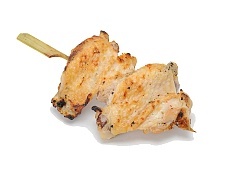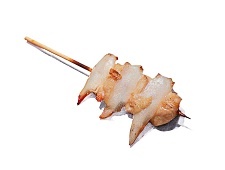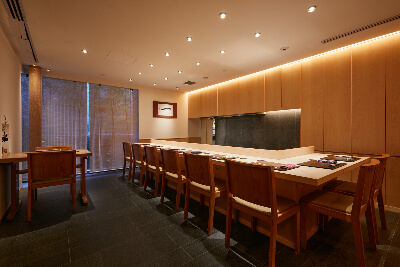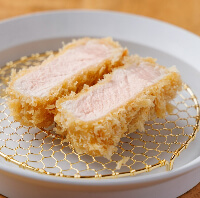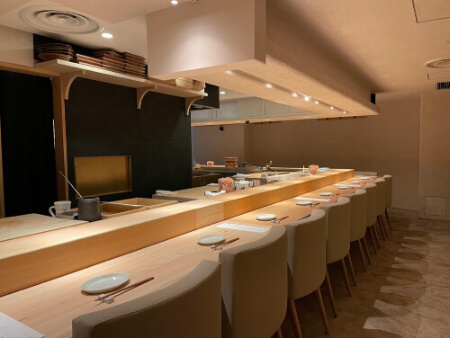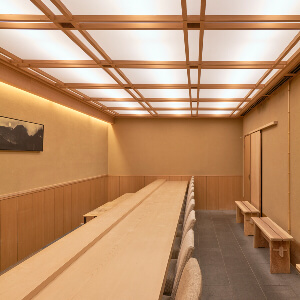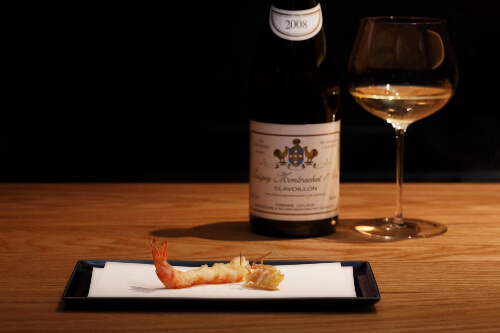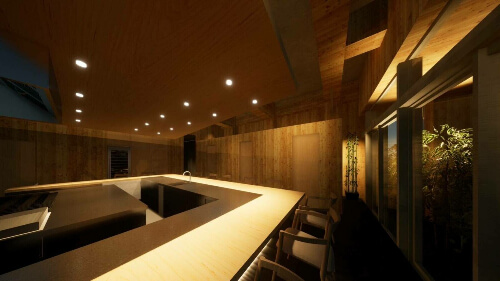Yakitori
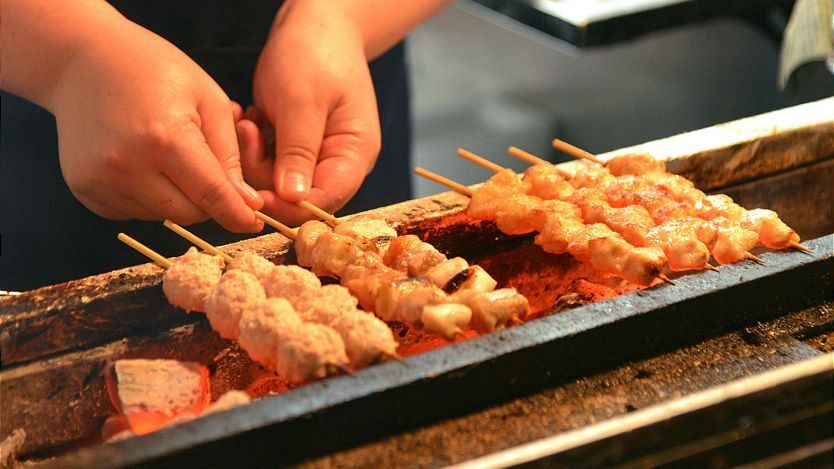
Yakitori (焼き鳥) are grilled chicken skewers made from bite sized pieces of meat from all different parts of the chicken, such as the breasts, thighs, skin, liver and other innards. Usually made to order and cooked over charcoal, yakitori is a popular, inexpensive dish commonly enjoyed together with a glass of beer. The best yakitori is served at specialty restaurants, known as yakitori-ya, but it can also be found at many other types of restaurants across Japan, such as izakaya, and at festival food stands.
Popular yakitori
Most yakitori restaurants also sell some non-chicken skewers such as skewered shishito peppers, cherry tomatoes, shiitake mushrooms or enoki mushrooms wrapped in bacon.

How to eat yakitori
Yakitori is an inexpensive and informal food that is easily found at specialized yakitori-ya, as well as at most izakaya and many other restaurants across Japan. At a typical yakitori-ya they are sold by the stick or a set of two sticks, and cost around 100-200 yen per stick. Many restaurants also offer combination plates with multiple types of yakitori (moriawase). Since yakitori are cooked to order and served hot off the grill, it may be better to order them in small batches rather than in a single large order.
When ordering yakitori, you usually can choose whether you want your skewers seasoned with a sweet and savory yakitori sauce (tare) or with salt (shio). Yakitori is meant to be eaten with your hands. You may directly eat them off the skewer or use your chopsticks to remove the meat from the skewer before consuming it. A small cup may be provided on the table to discard used skewers into.
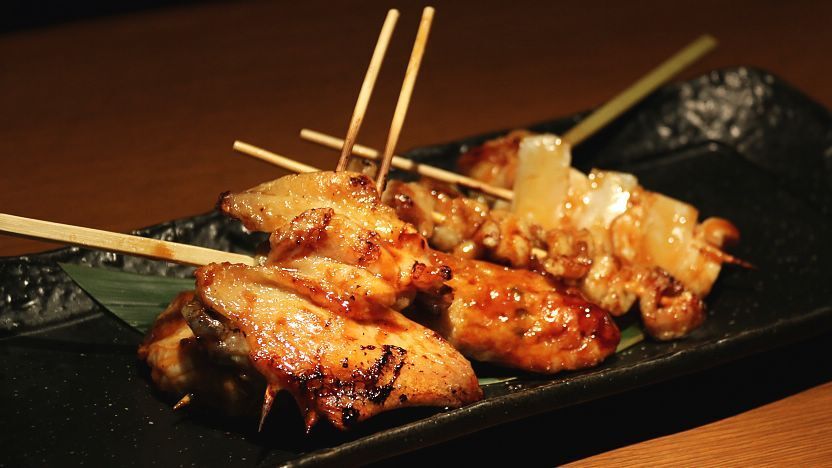
Where to eat yakitori
Yakitori is widely served across Japan, and especially easily found around large stations near business districts. Some specific, popular dining areas where you can eat yakitori are:
Questions? Ask in our forum.
Restaurants
-
-
![]() Udatsu Sushi (Tokyo)Awarded One Star in 2024 - People from around the world visit to experience Mr. Udatsu's sushi. Inside the restaurant, which resembles an art gallery with its modern decor and numerous artworks, guests can enjoy sushi crafted from the highest quality ingredients. While the foundation is traditional nigiri, the menu also features original creations born from the chef's relentless curiosity and innovation.View on JapanEatinerary
Udatsu Sushi (Tokyo)Awarded One Star in 2024 - People from around the world visit to experience Mr. Udatsu's sushi. Inside the restaurant, which resembles an art gallery with its modern decor and numerous artworks, guests can enjoy sushi crafted from the highest quality ingredients. While the foundation is traditional nigiri, the menu also features original creations born from the chef's relentless curiosity and innovation.View on JapanEatinerary -
![]() Waketokuyama (Tokyo)Awarded One Star in 2025 - With a meticulous focus on allowing guests to enjoy seasonal ingredients at their peak, the menu changes approximately every two weeks. The signature dish, "Grilled Abalone with Seaweed Aroma," features thick slices of abalone generously coated in a rich liver sauce, offering an exquisite taste of the sea.View on JapanEatinerary
Waketokuyama (Tokyo)Awarded One Star in 2025 - With a meticulous focus on allowing guests to enjoy seasonal ingredients at their peak, the menu changes approximately every two weeks. The signature dish, "Grilled Abalone with Seaweed Aroma," features thick slices of abalone generously coated in a rich liver sauce, offering an exquisite taste of the sea.View on JapanEatinerary -
![]() Sushiroku (Osaka)Awarded One Star in 2024 - A cozy, family-run restaurant managed by a husband and wife. They are deeply committed to perfecting their shari (sushi rice) and use two types of vinegared rice tailored to complement each topping. Since 2019, the restaurant has consistently earned stars.View on JapanEatinerary
Sushiroku (Osaka)Awarded One Star in 2024 - A cozy, family-run restaurant managed by a husband and wife. They are deeply committed to perfecting their shari (sushi rice) and use two types of vinegared rice tailored to complement each topping. Since 2019, the restaurant has consistently earned stars.View on JapanEatinerary -
![]() Fry-ya (Tokyo)Exquisite fried dishes crafted by a head chef with experience earning stars in both Switzerland and Japan. The remarkably light tonkatsu is a favorite not only among Japanese diners but also among visitors to Japan. With the theme of "small portions, many varieties," guests can enjoy sampling a wide selection of tonkatsu in smaller portions.View on JapanEatinerary
Fry-ya (Tokyo)Exquisite fried dishes crafted by a head chef with experience earning stars in both Switzerland and Japan. The remarkably light tonkatsu is a favorite not only among Japanese diners but also among visitors to Japan. With the theme of "small portions, many varieties," guests can enjoy sampling a wide selection of tonkatsu in smaller portions.View on JapanEatinerary -
![]() Sushi Hayashi (Kyoto)Awarded One Star in 2024 - A unique sushi restaurant that blends traditional Edomae (Tokyo-style) sushi with Kyoto-style sushi, such as mackerel sushi and steamed sushi, in its courses. The head chef, who trained as a sushi artisan in Switzerland, carefully selects Swiss wines, making them a perfect pairing to enjoy with the meal.View on JapanEatinerary
Sushi Hayashi (Kyoto)Awarded One Star in 2024 - A unique sushi restaurant that blends traditional Edomae (Tokyo-style) sushi with Kyoto-style sushi, such as mackerel sushi and steamed sushi, in its courses. The head chef, who trained as a sushi artisan in Switzerland, carefully selects Swiss wines, making them a perfect pairing to enjoy with the meal.View on JapanEatinerary -
![]() Hikarimono (Tokyo)With a prime location and quality that rivals high-end sushi restaurants, this restaurant maintains the goal of being a place for everyday dining. It offers a casual and relaxed atmosphere, free from stiffness or formality. The signature "Hikari-maki," featuring ingredients such as sardines, pickled plum, and bettarazuke (sweet pickled radish), boasts unique flavors that are especially popular among international visitors.View on JapanEatinerary
Hikarimono (Tokyo)With a prime location and quality that rivals high-end sushi restaurants, this restaurant maintains the goal of being a place for everyday dining. It offers a casual and relaxed atmosphere, free from stiffness or formality. The signature "Hikari-maki," featuring ingredients such as sardines, pickled plum, and bettarazuke (sweet pickled radish), boasts unique flavors that are especially popular among international visitors.View on JapanEatinerary -
![]() Noguchi Tsunagu (Kyoto)Awarded One Star in 2024 - The sister restaurant of the highly exclusive Japanese cuisine establishment, Kyotenjin Noguchi. While maintaining the culinary essence of the main branch, this kappo-style restaurant incorporates ingredients from the chef窶冱 hometown in the Goto Islands. Its signature dish, Nikusui, is a masterpiece made from carefully prepared, top-quality A5-grade sirloin.View on JapanEatinerary
Noguchi Tsunagu (Kyoto)Awarded One Star in 2024 - The sister restaurant of the highly exclusive Japanese cuisine establishment, Kyotenjin Noguchi. While maintaining the culinary essence of the main branch, this kappo-style restaurant incorporates ingredients from the chef窶冱 hometown in the Goto Islands. Its signature dish, Nikusui, is a masterpiece made from carefully prepared, top-quality A5-grade sirloin.View on JapanEatinerary -
![]() TEMPURA & WINE SHINO (Tokyo)The kind of restaurant that is known only to true gourmets, serving as a sort of 'Hidden gem'. In a chic space with black walls and a ceiling adorned in gold, you can enjoy tempura with a light and elegant texture, delicately fried using refined techniques to achieve a thin, white batter that minimizes the aroma of oil. Savor tempura that maximizes the flavors of the ingredients, paired with Champagne and Burgundy wines carefully selected by the sommelier.View on JapanEatinerary
TEMPURA & WINE SHINO (Tokyo)The kind of restaurant that is known only to true gourmets, serving as a sort of 'Hidden gem'. In a chic space with black walls and a ceiling adorned in gold, you can enjoy tempura with a light and elegant texture, delicately fried using refined techniques to achieve a thin, white batter that minimizes the aroma of oil. Savor tempura that maximizes the flavors of the ingredients, paired with Champagne and Burgundy wines carefully selected by the sommelier.View on JapanEatinerary -
![]() Ginza Nominokoji Yamagishi (Tokyo)Tominokoji Yamagishi, an exclusive kaiseki restaurant from Kyoto, has opened its first location in Tokyo. Unlike its main branch, this establishment adopts an izakaya-style format, allowing diners to enjoy a more relaxed テ� la carte dining experience. Despite being located in Tokyo, the restaurant meticulously sources ingredients and even water from Kyoto, dedicating itself to faithfully recreating Kyoto窶冱 culinary traditions.View on JapanEatinerary
Ginza Nominokoji Yamagishi (Tokyo)Tominokoji Yamagishi, an exclusive kaiseki restaurant from Kyoto, has opened its first location in Tokyo. Unlike its main branch, this establishment adopts an izakaya-style format, allowing diners to enjoy a more relaxed テ� la carte dining experience. Despite being located in Tokyo, the restaurant meticulously sources ingredients and even water from Kyoto, dedicating itself to faithfully recreating Kyoto窶冱 culinary traditions.View on JapanEatinerary -
![]() Kitashinchi Kushikatsu Bon (Osaka)A restaurant that elevates Osaka's soul food, kushikatsu, to a luxurious level. Skilled chefs meticulously prepare each skewer using carefully selected premium ingredients such as Chateaubriand and foie gras. The skewers are fried in a custom copper pot using a unique oil blend based on cottonseed oil, enhancing the natural flavors of the ingredients.View on JapanEatinerary
Kitashinchi Kushikatsu Bon (Osaka)A restaurant that elevates Osaka's soul food, kushikatsu, to a luxurious level. Skilled chefs meticulously prepare each skewer using carefully selected premium ingredients such as Chateaubriand and foie gras. The skewers are fried in a custom copper pot using a unique oil blend based on cottonseed oil, enhancing the natural flavors of the ingredients.View on JapanEatinerary
-




